| The Hanshinkan Kid (2): At Nishinomiya Shrine, a forest filled with Haruki Murakami's childhood memories |
||
| @@@ | ||
| A passage in Haruki Murakamifs novel gKafka on the Shoreh stirred fond memories of the
walks I took on a forest path with my elementary school classmates in Nishinomiya, Hyogo Prefecture. gThe woods werenft very deep, but the trees were hugely ancient, the tangle of their branches looming darkly above. A strong grassy odor came from the ground below,h the passage went. | ||
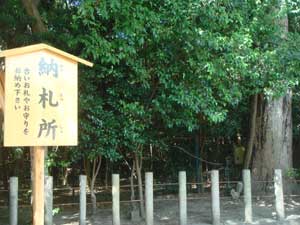 @ @ |
||
| Woods in Nishinomiya Shrine | ||
| The forest in gKafka on the Shoreh was in Shikoku. But the reclusive authorfs descriptions of
the shrine surrounded by that forest lead me to believe that Nishinomiya Shrine in
Nishinomiya was the inspiration for this setting. Nishinomiya Shrine was, after all, the place that left a big impression on Murakami, myself and many other children. Murakami and I were in the same school year, and he attended an elementary school close to mine in Nishinomiya, a city within the so-called Hanshinkan area between Osaka and Kobe. We were both what Murakami calls gHanshinkan kids.h Nishinomiya Shrine, located close to the municipal Hamawaki elementary school that Murakami attended, also served as a childrenfs playground. At that time, boys in the neighborhood of the Shinto shrine let their imaginations run wild while playing a game that involved exploring the shrinefs forest for a good hideout. The boys would slip under a low fence to sneak into the forest and then build their gsecret bases.h They were rather simple hideouts made only by covering depressed ground with dead branches and fallen leaves. But they were big enough to conceal the children | ||
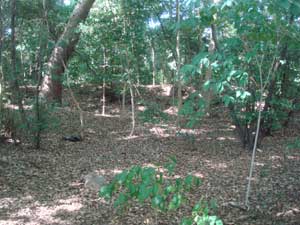 @ @ |
||
| The kids also bought gfu,h or wheat-gluten bread, at a nearby tea house to feed the turtles
and carp in a pond adjacent to the forest. Murakami wrote in an essay in gHenkyo Kinkyoh that he would stuff milk bottles with gudonh noodles and kneaded wheat flour to use as bait to catch shrimp in the pond. | ||
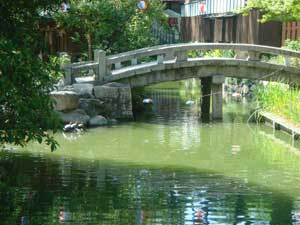 @ @ |
||
| Pond in the shrine | ||
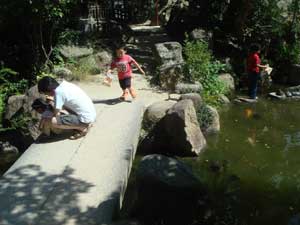 @ @ |
||
| One of main sites in gKafka on the Shoreh is a shrine in the city of Takamatsu on Shikoku island. The image of the shrine in his novel appears modeled after Nishinomiya Shrine and the boyhood memories that I share with Murakami. One of the main characters of the novel is Kafka Tamura, a 15-year-old boy who runs away from his home in Tokyo and heads to Takamatsu to become independent. When Kafka finds himself in a shrinefs forest, he says, gI had this feeling somewhere before.h Discussing gKafka on the Shoreh in an interview published in the 2004 summer edition of U.S. magazine Paris Review, Murakami said, gMy memory is like a chest: There are so many drawers in that chest, and when I want to be a 15-year-old boy, I open up a certain drawer and I find the scenery I saw when I was a boy in Kobe.h Kafkafs feelings in the shrinefs forest may have come from the drawer of Murakamifs chest of memories of when he was a boy of similar age. FOREST REMAINS UNCHANGED In May 1997, two years after Kobe, Nishinomiya and other communities were devastated by the Great Hanshin Earthquake, Murakami spent two days walking from Nishinomiya Station to Sannomiya, Kobe. During the journey, he visited Nishinomiya Shrine, which still showed signs of damage from the powerful quake. | ||
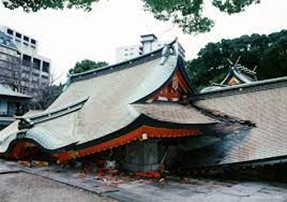 @ @ |
||
| Main hall of the shrine after the Great Hanshin Earthquake | ||
| Seeing that the top of a stone lantern in the shrine was missing, Murakami in gHenkyo
Kinkyoh wrote, gIt kind of looked like a relic.h But he also wrote, gOnly the deep forest within the precincts is there, unchanged from what it used to be in the old days in my memory, timeless and quietly dark.h gHenkyo Kinkyoh was published in 1998. gKafka on the Shoreh came out four years later, in 2002. Murakamifs childhood memories during that 1997 visit to Nishinomiya Shrine and the searing image of the quake damage are reflected in gKafka on the Shore.h In one scene in the novel, Kafka wanders around wounded and bleeding in the shrinefs forest, perhaps symbolizing the wounds inflicted on Murakamifs hometown by the disaster. Nishinomiya Shrine is the head shrine for the worship of Ebisu, a god of onefs occupation and one of the seven deities of good fortune. Japan has about 3,500 Ebisu shrines. | ||
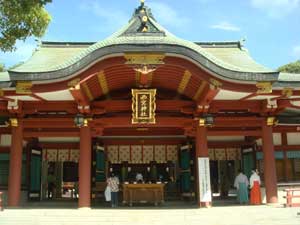 @ @ |
||
| Nishinomiya Shrine is also known for its Toka-Ebisu festival, held for three days from Jan. 9 every year. During the festival, which attracts more than 1 million worshippers, the shrine turns itself into a large entertainment complex, featuring various street stalls, a circus tent, gfreak showh tents, ring-tossing shops, and pachinko machines for kids. The festival culminates with the exciting and nationally famous gLucky Manh race held early on Jan. 10. A legion of participants sprint perilously over 200 meters from the shrinefs main gate to the main hall to be chosen as gLucky Men.h@ | ||
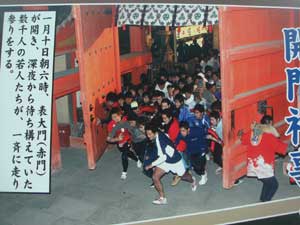 @ @ |
||
| Starting position of Lucky Man race | ||
|
In describing the shrine in his novel, however, Murakami makes no mention of its religious elements or its implications for Japanese spirituality. He only describes it as a simple religious facility that is mysterious and spiritual but can also serve as a childrenfs playground. Various words are used for gjinja,h the Japanese word for Shinto shrine, in the many translations of the novel. Readers of these words will associate them with familiar religious facilities, such as churches, mosques, synagogues or Hindu or Buddhist temples. Murakamifs description of the shrine can rekindle childhood memories among readers around the world of playing, misbehaving and experiencing the mysterious nature within these facilities. This is just one aspect of his writing style that makes his works universal and accessible to readers across the world. It is nevertheless worth noting that Murakami described the shrine in gKafka on the Shoreh through his depictions of the forest. While working in Hong Kong and Singapore as a corporate employee, I visited various religious facilities. Few of them were surrounded by a forest. In his suggestive manner, Murakami may have been pointing to the Japanese worship of forests based on the belief that gods reside in trees. This belief lurks deep in their collective psyche. CENTER FOR PROMOTING CULTURE 27 years after the Great Hanshin Earthquake, Nishinomiya Shrine has completely recovered from the damage. Both its main building and other facilities are fully restored. | ||
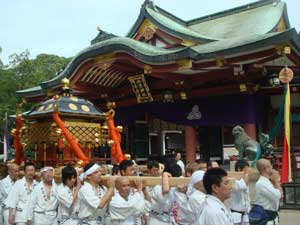 @ @ |
In addition to religious activities, a variety of secular events are held for citizens at the
shrine. In spring, members of the Hanshin Tigers professional baseball team, based in
Koshien Stadium in Nishinomiya, pray at the shrine for success in the new season. In early
summer, an exhibition of gsatsukih azaleas is held, followed by a show of chrysanthemums
in autumn. Local sake brewers also hold sales promotion events at the shrine. | |
 @ @ |
||
| Hanshin Tigers professional baseball team pray for success in the new season | ||
| Nishinomiya Shrine is also the base of a history study group that was created before World
War II and later changed its name to Nishinomiya Bunka Kyokai (Cultural Association). The association has served as a center that helps citizens promote culture. It publishes newsletters and organizes free lectures. I wrote a two-part series of articles titled gHaruki Murakami and Nishinomiya Shrineh for the associationfs newsletters. In October, I gave a lecture about Murakami in an assembly hall within the shrine. The shrinefs forest is now surrounded by a fence and is usually off-limits to the public. But several times a year, events are held to allow citizens to observe the forest, which has been designated as a natural monument. During these events, people take part in cleaning up the forest, the source of many fond childhood memories of Murakami and myself. | ||
Copyright Since 2009 OFFICE ATSURO KAWAUCHI. All rights reserved.